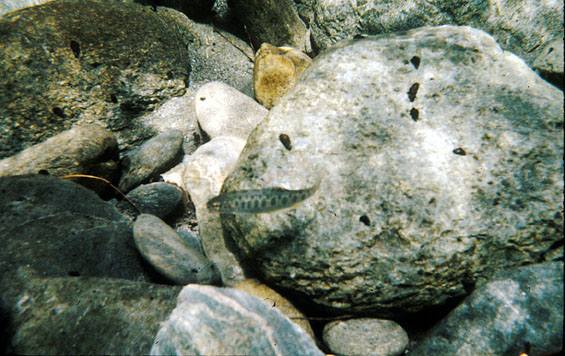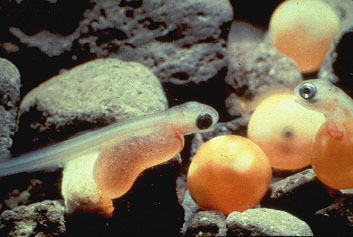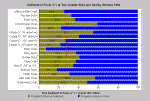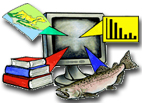Bibliography Background About KRIS
Sediment in Streams
 Excess sediment can profoundly effect the productivity of a salmon or trout stream (Cordone and Kelly, 1961). In a healthy stream, young salmon and trout hide in the interstitial spaces between cobbles and boulders to avoid predation . In streams that get extremely cold in winter, young steelhead may actually burrow into the streambed and spend the winter in flowing water down within the gravel. The area of the stream where flowing water extends down into the gravel is also extremely important for aquatic invertebrates, which supply most of the food for young salmon, steelhead and cutthroat trout. If fine sediment is clogging interstitial spaces between streambed gravel, juvenile salmonids lose their source of cover and food.
Excess sediment can profoundly effect the productivity of a salmon or trout stream (Cordone and Kelly, 1961). In a healthy stream, young salmon and trout hide in the interstitial spaces between cobbles and boulders to avoid predation . In streams that get extremely cold in winter, young steelhead may actually burrow into the streambed and spend the winter in flowing water down within the gravel. The area of the stream where flowing water extends down into the gravel is also extremely important for aquatic invertebrates, which supply most of the food for young salmon, steelhead and cutthroat trout. If fine sediment is clogging interstitial spaces between streambed gravel, juvenile salmonids lose their source of cover and food.
 Salmon, steelhead and coastal cutthroat trout are also very susceptible to sediment pollution because they build their nests in the stream bottom. The eggs, buried one to three feet deep in the gravel redd, rely on a steady flow of clean, cold water to deliver oxygen and remove waste products. In coastal streams the eggs usually hatch in about 30 days, depending on water temperatures. Eggs hatch into alevin and remain in the gravel another 30 days or so, living on the nutrients in their yolk sacs. As they develop into fry, the yolk is used up, and the fry must emerge through spaces in the gravel to take up life in the stream. During the 60 day period when eggs and alevin are in the gravel, major shifts of the stream bottom can kill them (Nawa and Frissell, 1993.)
Salmon, steelhead and coastal cutthroat trout are also very susceptible to sediment pollution because they build their nests in the stream bottom. The eggs, buried one to three feet deep in the gravel redd, rely on a steady flow of clean, cold water to deliver oxygen and remove waste products. In coastal streams the eggs usually hatch in about 30 days, depending on water temperatures. Eggs hatch into alevin and remain in the gravel another 30 days or so, living on the nutrients in their yolk sacs. As they develop into fry, the yolk is used up, and the fry must emerge through spaces in the gravel to take up life in the stream. During the 60 day period when eggs and alevin are in the gravel, major shifts of the stream bottom can kill them (Nawa and Frissell, 1993.)

Koski (1966) and Tappel and Bjornn (1983) demonstrated that increased fine sediment in spawning gravels caused decreased survival and emergence of salmonid eggs and alevin. McNeil and Ahnell (1964) found fines less than 0.85 mm (0.833 was actual sieve size) to have the highest impact on salmonid spawning success. Particles of less than 6.4 mm are recognized as having the potential to infiltrate redds forming a layer in the stream gravels which sometimes prevents emergence of fry (Lisle, 1989). Kondolf (2000), in a review of the literature, found that when fines (<6.4 mm) exceeded 30% that it reduced salmonid emergence and survival by 50%. Chapman (1988) showed different responses to similar levels of fines from various field studies (Figure 5 from Chapman) and noted that laboratory experiments might not duplicate redd dynamics.
Studies conducted in redds in Olympic Peninsula streams in Washington found that if more than 13% fine sediment (<0.85 mm) intruded into the redd, almost no steelhead or coho salmon eggs survived (McHenry et al., 1994). Barnard (1992) showed that fine sediment levels inside and outside coho salmon redds varied substantially in Freshwater Creek, a tributary to Humboldt Bay. Fines (<1 mm) averaged seven percent inside redds and 13% outside them, with no inside redd measurement in excess of 13%.
While salmon have the ability to substantially lower fine sediment in the redd pocket during redd construction, if fine sediment levels in the stream bed outside the redd are high, there is a potential for fines to intrude into already constructed redds during high flows (Kondolf, 2000). Because the redd is a depression in the stream bed, it creates Venturi forces, drawing water down into the gravel. Fine sediment in suspension during storms may be sucked down into the redd.
Lotspeich and Everest (1983) noted that pore space and permeability were key variables in the quality of salmonid spawning gravel, and suggested using the central tendency of particles (FREDLE Index) as a standard. They postulated that, because of varying head diameters, coho salmon have less success emerging as fry than steelhead trout when fine sediment levels in redds are high. Barnard and McBain (1994) suggested that measuring permeability itself might be a quicker, and more cost effective, method of measuring sediment impacts on salmonids. McBain and Trush (2000) concluded that measuring permeability defined "the variability in spawning gravel quality with better resolution and at lower cost than substrate composition analysis, but the relationship between permeability and salmonid egg survival is less well known."
 Suspended sediment in the water column causes turbidity. Sigler et al. (1984) found that turbidities as low as 25 nephlometric turbidity units (ntu) caused a reduction in juvenile steelhead and coho growth. High turbidity during winter likely impacts the feeding ability of juvenile salmon, steelhead or cutthroat trout, and the longer the duration of high turbidity the more damage is likely to fish and other aquatic organisms (Newcombe and MacDonald, 1991). Higgins (2002) noted measurement of turbidity in excess of 25 ntu for weeks at a time in Freshwater Creek (Humboldt County) in the winter of 1999, after widespread logging in the watershed upstream in a relatively short duration.
Suspended sediment in the water column causes turbidity. Sigler et al. (1984) found that turbidities as low as 25 nephlometric turbidity units (ntu) caused a reduction in juvenile steelhead and coho growth. High turbidity during winter likely impacts the feeding ability of juvenile salmon, steelhead or cutthroat trout, and the longer the duration of high turbidity the more damage is likely to fish and other aquatic organisms (Newcombe and MacDonald, 1991). Higgins (2002) noted measurement of turbidity in excess of 25 ntu for weeks at a time in Freshwater Creek (Humboldt County) in the winter of 1999, after widespread logging in the watershed upstream in a relatively short duration.
Coho and chinook salmon do not have the leaping ability of steelhead and are, therefore, confined to low gradient reaches. These reaches were formerly the most productive spawning and rearing areas, with an ample supply of good gravel and large wood. High bedload transport can bury low gradient reaches, making them much simpler and less productive salmonid habitat. These formerly productive low gradient reaches become wide and shallow and recovery of fish habitat may take decades (Frissell, 1992). Lisle (1981) noted that recovery of streams with high gradient proceeds much more rapidly following large flood events.
 Knopp (1993), in a study of 60 northwestern California streams, found that intensive land use management was correlated to loss of pool volume. In the chart from Knopp (1993) at left, Elder Creek, an unmanaged watershed, had roughly 7% of its pool volumes filled by sediment while logged streams sometimes were over half filled (>0.50 V*). During the year they spend in freshwater, coho salmon prefer deep pools that form around large pieces of wood. High sediment transport can fill pools and cause reduction or loss of essential salmonid juvenile rearing habitat (Frissell, 1992). Brown et al. (1994) noted that optimal coho habitat is comprised of pools at least one meter deep (39 inches), and Reeves (1988) found that yearling and older steelhead juveniles needed pools at least three feet deep for successful rearing
Knopp (1993), in a study of 60 northwestern California streams, found that intensive land use management was correlated to loss of pool volume. In the chart from Knopp (1993) at left, Elder Creek, an unmanaged watershed, had roughly 7% of its pool volumes filled by sediment while logged streams sometimes were over half filled (>0.50 V*). During the year they spend in freshwater, coho salmon prefer deep pools that form around large pieces of wood. High sediment transport can fill pools and cause reduction or loss of essential salmonid juvenile rearing habitat (Frissell, 1992). Brown et al. (1994) noted that optimal coho habitat is comprised of pools at least one meter deep (39 inches), and Reeves (1988) found that yearling and older steelhead juveniles needed pools at least three feet deep for successful rearing
Cordone and Kelly (1961) documented the problems of sediment waves associated with Post WW II logging in California and concluded:
"More than anything else we need to develop a philosophy of land husbandry that will avoid the creation of untreated and running sores on the earth's surface. Man must acquire a responsibility to future generations that matches the power he has gained through the development of heavy machinery. Our observations in the field and our review of the existing literature leads us to the unshakable conclusion that unless this can be done many of our trout streams will be destroyed by the deposition of sediment."
References
Barnard, K. 1992. Physical and Chemical Conditions in Coho Salmon (Oncorhynchus kisutch) Spawning Habitat in Freshwater Creek, Northern California. Masters Thesis. Humboldt State University. Arcata CA. 81 pp. without appendices.
Barnard, K. & S. McBain. 1994. Standpipe to Determine Permeability, Dissolved Oxygen, and Vertical Particle Size Distribution in Salmonid Spawning Gravels. As FHR Currents # 15. US Forest Service, Region 5. Eureka, CA. 12 pp.
Chapman. D.W. 1988. Critical Review of Variables Used to Define Effects of Fines in Redds of Large Salmonids. Transactions of the American Fisheries Society. 117: 1-21.
Cordone, A.J. and D.W. Kelley. 1961. The influences of inorganic sediment on the aquatic life of streams. Reprint from California Fish and Game. Vol. 47, No. 2. California Department of Fish and Game, Inland Fisheries Branch. Sacramento, CA. 41 pp. [155k]**
Frissell, C.A. 1992. Cumulative effects of land use on salmonid habitat on southwest Oregon streams. Ph.D. thesis, Oregon State University, Corvalis, OR.
Knopp, C. 1993. Testing Indices of Cold Water Fish Habitat. Final Report for Development of Techniques for Measuring Beneficial Use Protection and Inclusion into the North Coast Region's Basin Plan by Amendment of the.....Activities, September 18, 1990. North Coast Regional Water Quality Control Board in cooperation with California Department of Forestry. 57 pp.
Kondolf, G.M. 2000. Assessing Salmonid Spawning Gravel Quality. Trans. Am. Fish. Soc. 129:262-281.
Koski, K Victor. 1966. The survival of coho salmon (Oncorhynchus kisutch) from egg deposition to emergence in three Oregon coastal streams. Master's thesis, Oregon State University. 98 pp. [905k]**
Lisle, T. E. 1981. Channel recovery from recent large floods in north coastal California: rates and processes. Pages 153-160, in: R. N. Coates (ed.), Proceedings, Symposium on Watershed Rehabilitation in Redwood National Park and Other Pacific Coastal Areas; 25-28 August 1981; Arcata, California. Sacramento, California: Center for Natural Resources Studies of JMI, Inc. [92k] http://www.rsl.psw.fs.fed.us/projects/water/lisle81.pdf
Lisle, T. E. 1989. Sediment transport and resulting deposition in spawning gravels, north coastal California. Water Resources Research 25(6): 1303-1319. [487k] http://www.rsl.psw.fs.fed.us/projects/water/Lisle89.pdf
Lotspeich, F.B. and F.H. Everest. 1981. A new method for reporting and interpreting textural composition of spawning gravel. Pacific Northwest Forest and Range Experiment Station, Research Note PNW-369.USDA Forest Service. Corvallis, OR. 12 pp. [242k]**
McHenry, M.L., D.C. Morrill and E. Currence. 1994 . Spawning Gravel Quality, Watershed Characteristics and Early Life History Survival of Coho Salmon and Steelhead in Five North Olympic Peninsula Watersheds. Lower Elwha S'Klallam Tribe, Port Angeles, WA. and Makah Tribe, Neah Bay, WA. Funded by Washington State Dept. of Ecology (205J grant).
Nawa, R.K. and C.A. Frissell. 1993. Measuring scour and fill of gravel stream beds with scour chains and sliding bead monitors. No. American J. of Fisheries Management. 13: 634-639.
Newcombe, C.P. and D.D. MacDonald. 1991. Effects of Suspended Sediments on Aquatic Ecosystems. North American Journal of Fisheries Management. 11: 72-82.
McNeil, W. J. and W.H. Ahnell. 1964. Success of Pink Spawning Relative to Size of Spawning Bed Material. U.S. Fish and Wildlife Service, Special Scientific Report - Fisheries No. 469. Washington, D.C. 17 pp.
Sigler, J.W., T.C. Bjornn and F.H. Everest. 1984. Effects of Chronic Turbidity on Density of Steelheads and Coho Salmon. Transactions of the American Fisheries Society, 113: 142-150.
Tappel, P.D., and T.C. Bjornn. 1983. A new method of relating size of spawning gravel to salmonid embryo survival. North American Journal of Fisheries Management 3:123-135. [247k]**
